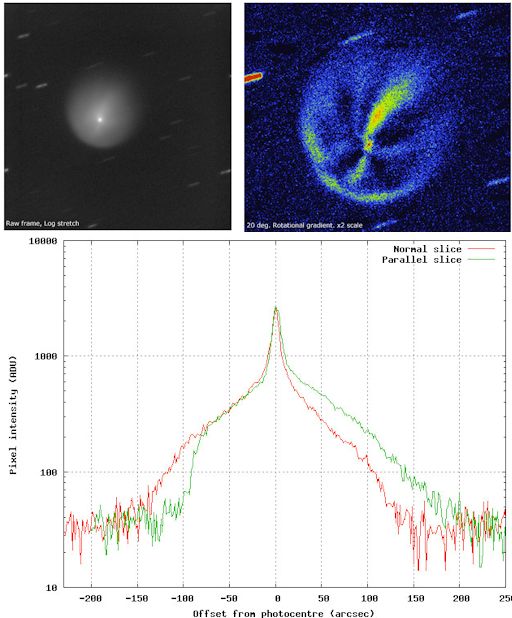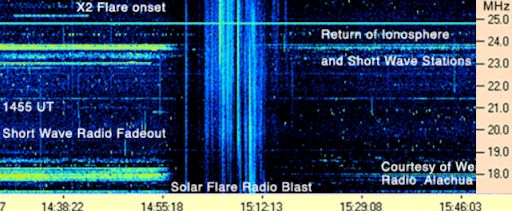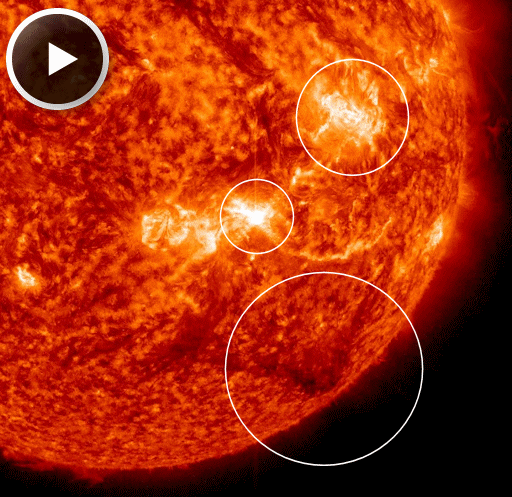WEAK IMPACT, MORE TO COME: A CME swept past Earth during the late hours of Oct. 26th, but its impact was weak and did not spark significant geomagnetic activity. Attention now shifts to Oct. 28th when the first of the CMEs from last week's X-flares is expected to deliver a glancing blow to Earth's magnetic field. NOAA forecasters estimate a 20% chance of polar geomagnetic storms. Aurora alerts: text, voice.
COMET LINEAR X1: The sun isn't the only thing exploding. Almost 450 million km from Earth, Comet C/2012 X1 (LINEAR) is having its own outburst. On Oct. 20th, amateur astronomers realized that the comet's brightness had increased 100-fold and its morphology resembled that of exploding Comet 17P/Holmes in 2007. Follow-up images in recent nights seem to show jet-like structures in Comet LINEAR X1's expanding atmosphere. Amateur astronomer Nick James of Chelmsford, UK, obtained these data on Oct. 26th:
Another set of images taken by James shows the comet's atmosphere or "coma" expanding over a period of two days. "The coma's diameter is increasing at a rate of 30 arcseconds per day," says James. "At a distance of 2.95 AU this corresponds to 65,000 km/day or a little less than 1 km/s." He made these observations using an 11-inch Celestron telescope.
Located in the constellation Coma Berenices, Comet LINEAR X1 rises in the east about an hour before the sun. The low altitude of the comet in morning twilight is a challenge, but because the comet is fairly bright, magnitude +8.5, it is still a relatively easy target for backyard telescopes equipped with digital cameras. Monitoring is encouraged! Resources: 3D orbit, ephemeris, sky map.
X2-FLARE BLASTS EARTH'S IONOSPHERE: Electromagnetic radiation from the X2-class solar flare of Oct. 25th had a significant effect on Earth's upper atmosphere. As a wave of ionization swept across the dayside of the planet, the normal propagation of shortwave radio signals was scrambled. In Alachua, Florida, electrical engineer Wes Greenman recorded the effects using his own shortwave radio telescope. Click on the frequency-time plot to view an animation:
During the time that terrestrial shortwave transmissions were blacked out, the sun filled in the gap with a loud radio burst of its own. In New Mexico, amateur radio astronomer Thomas Ashcraft recorded the sounds. "This radio burst was a strong one and might be too intense for headphones," cautions Ashcraft.
Solar radio bursts are caused by strong shock waves moving through the sun's atmosphere. (Electrons accelerated by the shock front excite plasma instabilities which, in turn, produce shortwave static.) They are usually a sign that a CME is emerging from the blast site--and indeed this flare produced a very bright CME. Solar flare alerts: text, voice.
Realtime Space Weather Photo Gallery
INTERCONNECTED SOLAR ACTIVITY: The X1-flare of Oct. 25th was remarkable not only for its strength, but also for its interconnectedness. The flare was bracketed by two erupting magnetic filaments, each located hundreds of thousands of kilometers from the instigating sunspot AR1882. The whole episoide, shown in this SDO movie, was reminiscent of the famous global eruption of August 2010.
On Oct. 26th it happened again. Click on this image of the sun's southwestern quadrant and watch a sequence of flare activity around sunspots AR1875 and AR1877 followed by a filament eruption off the SW limb:
Instead of being a sequence of unrelated events, these flares and eruptions are likely connected by magnetic fields, which thread through the whole broad region. Like dominoes falling, one explosion triggers another as shock waves follow magnetic fields from blast site to blast site.
The filament punctuated the sequence by hurling a part of itself into space. SOHO has observed a CME emerging from the blast site, but it is too soon to say whether it is heading for Earth. Stay tuned for updates. Solar flare alerts: text, voice.

Solar wind
speed: 275.2 km/sec
density: 3.6 protons/cm3
explanation | more data
Updated: Today at 1546 UT
X-ray Solar Flares
6-hr max: M3 1248 UT Oct27
24-hr: M3 1248 UT Oct27
explanation | more data
Updated: Today at: 1500 UT
![]()
Daily Sun: 27 Oct 13
Sunspots AR1875, AR1877 and AR1882 all have complex magnetic fields that harbor energy for strong eruptions. Credit: SDO/HMI
![]()
Sunspot number: 171
What is the sunspot number?
Updated 27 Oct 2013
Spotless Days
Current Stretch: 0 days
2013 total: 0 days (0%)
2012 total: 0 days (0%)
2011 total: 2 days (<1%)
2010 total: 51 days (14%)
2009 total: 260 days (71%)
Since 2004: 821 days
Typical Solar Min: 486 days
Update 27 Oct 2013
The Radio Sun
10.7 cm flux: 165 sfu
explanation | more data
Updated 27 Oct 2013
![]()
Current Auroral Oval:
Switch to: Europe, USA, New Zealand, Antarctica
Credit: NOAA/POES
![]()
Planetary K-index
Now: Kp= 1 quiet
24-hr max: Kp= 1 quiet
explanation | more data
Interplanetary Mag. Field
Btotal: 2.9 nT
Bz: 1.3 nT south
explanation | more data
Updated: Today at 1546 UT
![]()
Coronal Holes: 27 Oct 13
There are no large coronal holes on the Earthside of the sun. Credit: SDO/AIA.








Comments
PLANET X IS PROTECTING US FROM CME´S
PLANET X IS PROTECTING US FROM CME´S !!!
http://youtu.be/zaldpRbtfog
Really nice wouldn't it be kewl if with the solar meteorites exI
Nice blog
Brian Whisper
Yeah flaires
So kewl if with the solar reverse it may cause a near miss of the 4- solar flaires ,x and m apparent in our field no geo-magnetic shut down and as Ion approaches weakened from the sun leaving it's genetic dust as a gift.
Brian Whisper